cold calling is a must for sales teams: the good news is that it can be made much easier and more effective by defining a telephone call plan.
What is a call plan? How do you make one? What is the CROC method? How to present yourself during a phone call? In this article, we reveal all the secrets of this indispensable tool for your sales strategy.
Sommaire
What is a telephone call plan?
Telephone Call Plan: Definition
A cold calling plan is the document on which the sales representative or the person who has to establish business relations during a cold calling campaign relies.
Why write a phone plan?

The call plan is a roadmap for sales teams, setting out objectives to be achieved and defining the key points to be addressed in the first conversation with the prospect: the call plan provides a common thread, which prevents the salesperson from losing focus during the exchange.
The objective is to reach a clear conclusion on the next step in the relationship by communicating a simple and precise message to the prospect.
How do you make a telephone call plan?
The telephone call plan is a very important tool for successful cold calling: here are the five elements that should not be neglected when developing it.
- Validated research on the prospect: beforehand, find out about the activities of the company contacted (products and services, results, competitors, teams, etc.) to personalise the message as much as possible.
- Identified objectives: from the information gathered, determine as quickly as possible the objectives of the prospect and his company in order to highlight the added value of your offer in relation to them.
- Clearly identified challenges: by identifying their objectives, also understand what difficulties they have in achieving them. This then allows you to specify the solutions you can offer.
- A tactical suggestion: from the first call, if the prospect is well identified, propose a tactical suggestion, showing how your product or service meets their objectives.
- The plan for the next steps to be taken: if the prospect seems interested, close the discussion by preparing the next step: for example, if they would like a demonstration of your product or service, take advantage of this to arrange an appointment directly.
Going further
For this last tip, see our guide on how to get closer on the phone.
Tired of Excel files? A good CRM software allows you to take your prospecting to the next level. Discover our selection of the best free CRM software
What is the CROC method?
CROC method: the definition
The CROC method (Contact, Reason for Calling, Objective, Conclusion) is a communication strategy that can be used on the telephone. The idea is to put the caller at ease in order to facilitate the discussion.
- Contact: refers to making contact with the prospect. To establish a relationship of trust, start by introducing yourself and your company. But don’t forget to ask your contact questions to define their needs.
- Reason: it is better to explain the exact reason for the appeal precisely and clearly.
- Objective: after explaining the reason for the call, you should tell them your objective (which has been precisely defined in your telephone call plan).
- Conclusion: before saying goodbye to your interviewer, it is essential to rephrase the essential points with him or her and invite him or her to follow up on your exchange.
Why use the CROC method for your call plans?
The CROC method has become indispensable for effective cold calling: it not only saves time but also structures your call. With this tool, the salesperson already knows what to say to the customer and has an idea of how the conversation might turn out. He is prepared for any eventuality and can overcome any doubts the prospect may have. Self-confidence is essential to convince a potential customer.
Tired of Excel files? A good CRM software allows you to take your prospecting to the next level. Discover our selection of the best free CRM software
Our templates for telephone call plans
Here we present our sample call plans, depending on the purpose of the call and whether or not there is an existing relationship with the prospect.
Telephone call plan: Talking to a prospect who doesn’t know you

Passing the switchboard
Passing the standard is an art.
Don’t assume that you will be put in touch with the decision maker. Instead, brush the operator off with this sample sales script:
“Hello, my name is Thomas. I was wondering if you could help me. I’ve looked at [COMPANY]’s LinkedIn page but I can’t find your name. Are you usually the person who answers the phone? Can I ask for your name before I ask you a favor?”
(Repeat the name of the switchboard and thank it).
“I would like to speak to [NAME OF PROSPECTOR]/person in charge of X. What is the best way to do this?”
Here you collaborate with the operator instead of seeing him as an obstacle. The idea is to establish the same relationship with the operator that you will build with your prospects.
Provide your prospect with options
Instead of assuming the profile of your prospects, you can opt for a “choose your own adventure” approach.
“Hello, this is Thomas de Salesdorado. How are you?
We are working on solutions to help you recruit and train a new generation of salespeople. Would you like to know more?”
(If “yes”).
“Companies can work with us in two ways. Either we help them find salespeople in exchange for a percentage of the base salary, or we help them train new salespeople through our online sales training programmes that teach them how to turn prospects from curiosity seekers into customers. Which one might you be interested in?”
(They choose one or the other).
“Great. Can I ask you some questions first?”
(You ask them qualifying questions to know what to present).
“I’ll tell you a bit more about it and then, if it’s OK with you, we can arrange a meeting later to talk about it in more detail. Is that OK with you?”
From there, you tell them a little more about the programme, just enough to get them to agree to an appointment, and then you can move on to your appointment setting script.
This method is smart because it elicits a “micro yes” from the prospect early in the call. By offering prospects a choice, they become invested in the call and are more likely to listen to the message you have to share.
“I’m calling from a friend
How can you make a cold call warmer?
Answer: tell them that a mutual relationship has suggested that you contact them. Here’s how to do it:
“Hello [NAME],
Axel and I have had great results with Salesdorado’s marketing automation system and he suggested that you might be interested.
Congratulations on [RESULT]. What you are doing at [COMPANY PROSPECT] is impressive!
I would like to explain how we helped Axel to generate [RESULT] and how we could do the same for you. Would you be interested?”
From there, you can schedule the appointment as you normally would.
The prospect is likely to ask you some questions: you can follow the usual procedure, and if in doubt suggest that they ask Axel, your mutual friend.
Use a highly personalised tagline
Social networks allow you to obtain a considerable amount of information about your prospects.
There is a reason why LinkedIn prospecting is a salesperson’s best friend: use this information to open the call and create familiarity from the start. Here is a sample script for using this hook:
“I noticed that you worked at [OLD COMPANY], how did you find the culture of that company?”
“A friend of mine also studied at [UNIVERSITY], what did you study there?”
“I see you’ve come up through the ranks in your company, how did you get noticed by management?”
If they open up, continue the conversation a little longer. If not, get back on track and keep your goal in mind.
Exploiting weak signals
There are various signals that a prospect or target account needs what you offer, such as a new hire for a specific role.
The following call plan is proposed here:
“Hello [NAME].
My name is Thomas, from Salesdorado, and I’m calling because I’ve noticed that you’re recruiting new SDRs from [JOB SITE NAME]. I guess you’re recruiting because you need more meetings, and we happen to offer a prospecting platform designed to get teams more qualified meetings.
It would be worth a 10 minute chat to see if it would be a good fit for your needs, so you can be offered a new interview. I can even show you how to see the emails and contact information displayed, instantly.”
Appeal plan: Bouncing on objections
“I don’t have time”

This is usually a polite way of saying “you are not important enough at the moment”.
How to deal with this situation?
Show them that you are offering them something valuable that is worth their time.
Here is an effective response to this objection:
“I understand that it may not be a top priority for you at the moment, or perhaps you don’t see the value in it. Several people started out saying the same thing, but after a brief discussion, they were happy to learn more. Give me two minutes to convince you that you are not wasting your time with me.”
Leave a message
You will not always be able to reach your prospect right away.
They may be out of town, in a meeting, or just working.
You are offered a voicemail script to leave if your prospect does not respond:
“Hello, [NAME]. This is Thomas de Salesdorado.
I’m calling because I think I could help you improve the difficult process of recruiting employees, especially nurses. I wanted to know if it would be a good idea to have a short conversation to find out more about this.
You can reach me at [YOUR PHONE NUMBER].
Again, my name is Thomas de Salesdorado and you can reach me at [YOUR PHONE NUMBER].
Thank you, [NAME].”
It’s a bit like email prospecting: this message reads like a coldmail. It is short, to the point and tells the prospect exactly what to do next.
There are many ways to match your coldmails to your coldcalls: you can experiment with different approaches to see what gets the best response rate.
Going further
To make sure you get as many responses as possible, here are the best times for your prospecting calls.
Calling plans: Follow up your prospects
Getting to know you

A multi-channel approach creates familiarity and turns your cold call into a slightly warmer moment, which can help you convert your prospect.
For this example, let’s say you have already established contact by email. You are offered a telephone call plan that immediately strengthens your relationship.
“Hello [NAME], this is Thomas from Salesdorado. I sent you an email last Thursday, have you had a chance to read it?
[Make a personalised response].
The reason I sent this email is because I noticed that you are in charge of sales processes and operations at [COMPANY]. Is that correct?”
From there, you can move on to your proposal, respond to any objections and set up the meeting.
Follow-up voice message
If you’ve already left a voicemail, chances are they know who you are. Here’s a script to follow up afterwards:
“Hello [NAME], I left a voicemail last week about X and thought this was a good time to call you back.
As I said in my message, we are offering [PRESENT YOUR OFFER]. I would be happy to show you how you can generate [RESULT].
Would you like to schedule a call to find out more?”
Here you simply refer to the voice message you left and repeat your offer. The next step is to use your usual cold calling plan.
Detail-oriented monitoring
Let’s say a prospect is really busy and asks you to call them back.
You’ve already told them why you’re calling, and you may even have sent them an email to give them the context for your next call.
If this is the case, you can use this script for monitoring:
“Hello [NAME], I will call you back as agreed. I hope I’m not disturbing you, have you had time to check my email?
Excellent! As I said, we help [COMPANY] like you to generate [RESULT]. As agreed, this is a quick two-minute call to see if our offer might be of interest to you. Do you mind if I ask you a few questions to better understand your needs and see how we might work together?”
From there, you can ask your own questions or go through your usual qualification process to assess whether you can meet your prospect’s needs.
This is not a full discovery call: it is simply a repeat of the beginning of the sales process. The idea is to fit in with your prospect’s schedule by making the most interesting offer possible.
Qualifying your prospects on the phone: our best scripts
Ask leading questions
Apart from their LinkedIn profile information, it is unlikely that you will know much about your prospect on the first call.
After introducing yourself and breaking the ice, you can try asking more specific questions. For example:
- What are the biggest challenges you currently face in your job?
- What tools and solutions do you use to overcome a problem?
- What was the decisive factor in recruiting new SDRs at [COMPANY]?
These questions lead your prospects to fill in the gaps in your profile.
Our opinion
This will not only allow you to tailor the rest of the conversation, but also to provide qualitative information to enrich your buyer personas.
Qualify your SaaS prospects
A classic problem with cold calling is that your caller has no way of knowing whether or not they are interested in what you have to offer.
Even with your best sales script, your prospect doesn’t know or trust you … yet.
To deal with this problem, don’t hesitate to ask the same questions you would ask after a “yes” when you hear a “no”. In other words, qualifying questions on the phone can also be used as objection handling questions.
These questions include:
- What are your biggest challenges in [ROLE]?
- Are you looking for a solution to this challenge? Why/why not?
- What does your current X process look like?
- What software and solutions do you currently use for X?
- Why did you decide to invest in these tools and solutions?
- What results do you hope to achieve in the next 6 months?
When dealing with objections, avoid the classic questions of a first prospecting call (who is the decision maker, what is your budget, etc.).
The aim is to get enough information to show the value that you and your solution can bring.
Our opinion
With this information, you can guide the conversation and show them how you can help them with their specific challenges and needs.
Tired of Excel files? A good CRM software allows you to take your prospecting to the next level. Discover our selection of the best free CRM software
Our tips for building effective appeal plans
We have presented several examples of telephone call plans that you can take up and adapt to your own sales processes. But following them blindly is not enough to become a great salesperson!
Here are our top seven cold call tips to help you with your prospecting calls.
Prepare your calls in depth to hyper-personalise your message
It is much easier to build a relationship if you know what your prospect does and what segments they are in.
To do this, you need the right information. This can take some time, so it is best to do this in the morning so that you have all this information in mind when you make the calls later in the day.
Start by looking at their LinkedIn profile, noting the following:
- Groups in which they are active
- Influencers they follow
- Recent professional changes (position, promotion)
- Content they have created or participated in
- Training, voluntary activities and place of residence.
For example, a prospect is a fan of Hunter Walk:
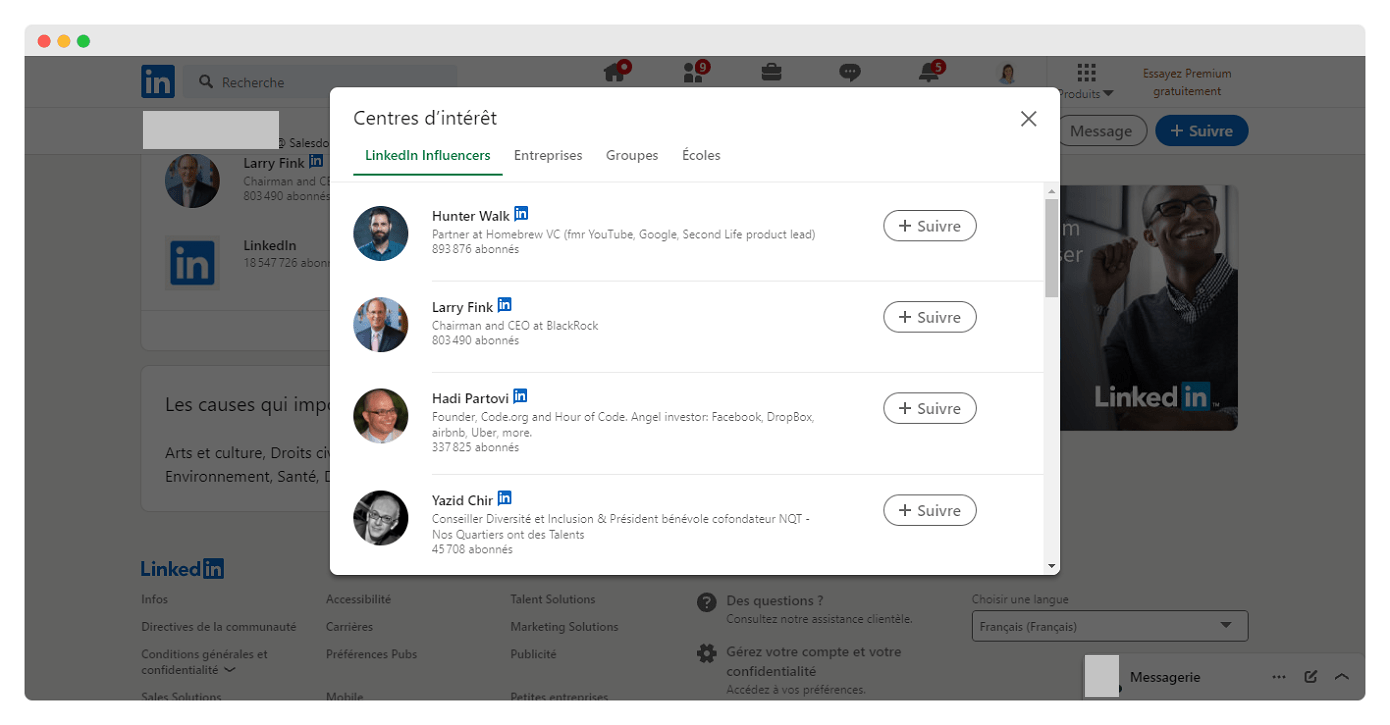
Using this information, you can tailor your call around macro-economic strategies, or even mention recent content that Hunter Walk has published.
If you are addressing high-level decision-makers, they are likely to create content themselves.
A quick Google search will show you what they do to build their own personal brand:
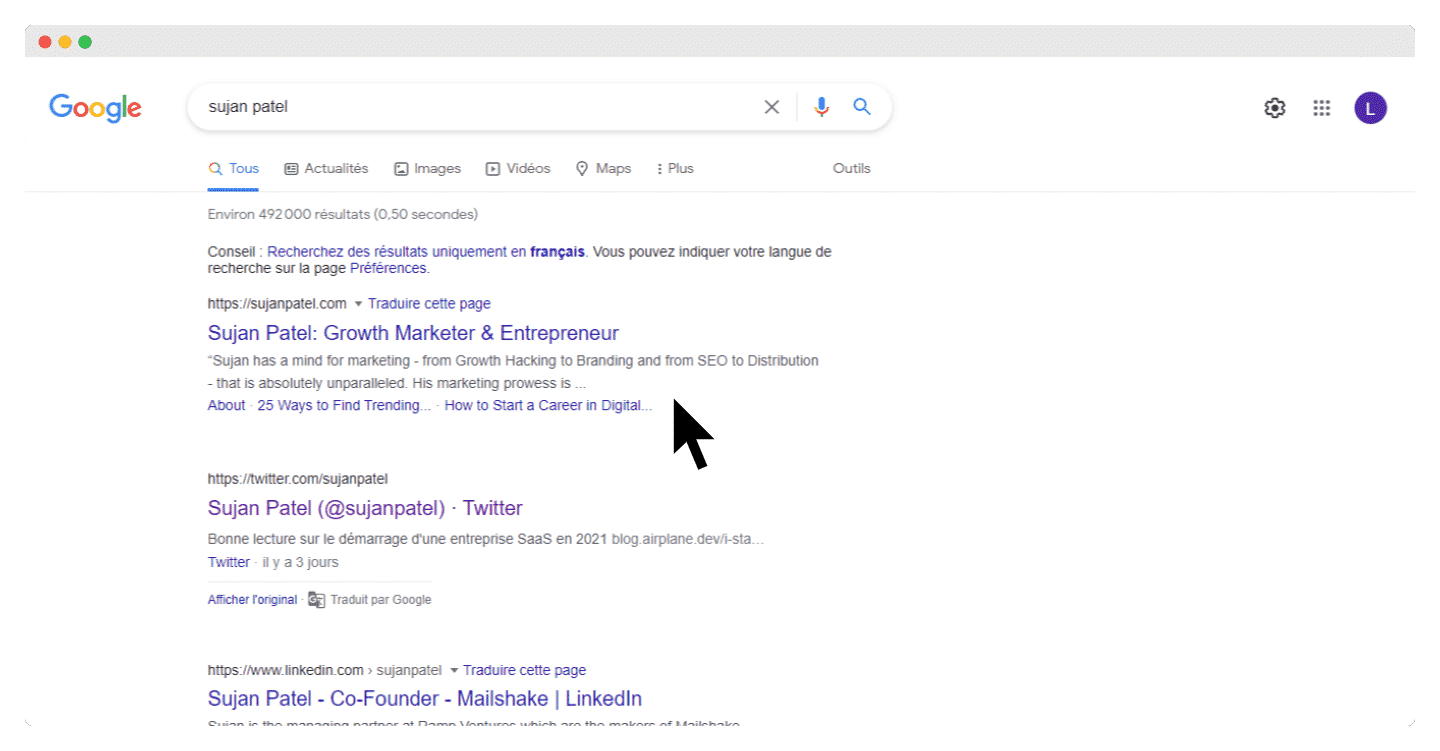
Check out their Twitter profile. If they create their own content, they are likely to share it here:
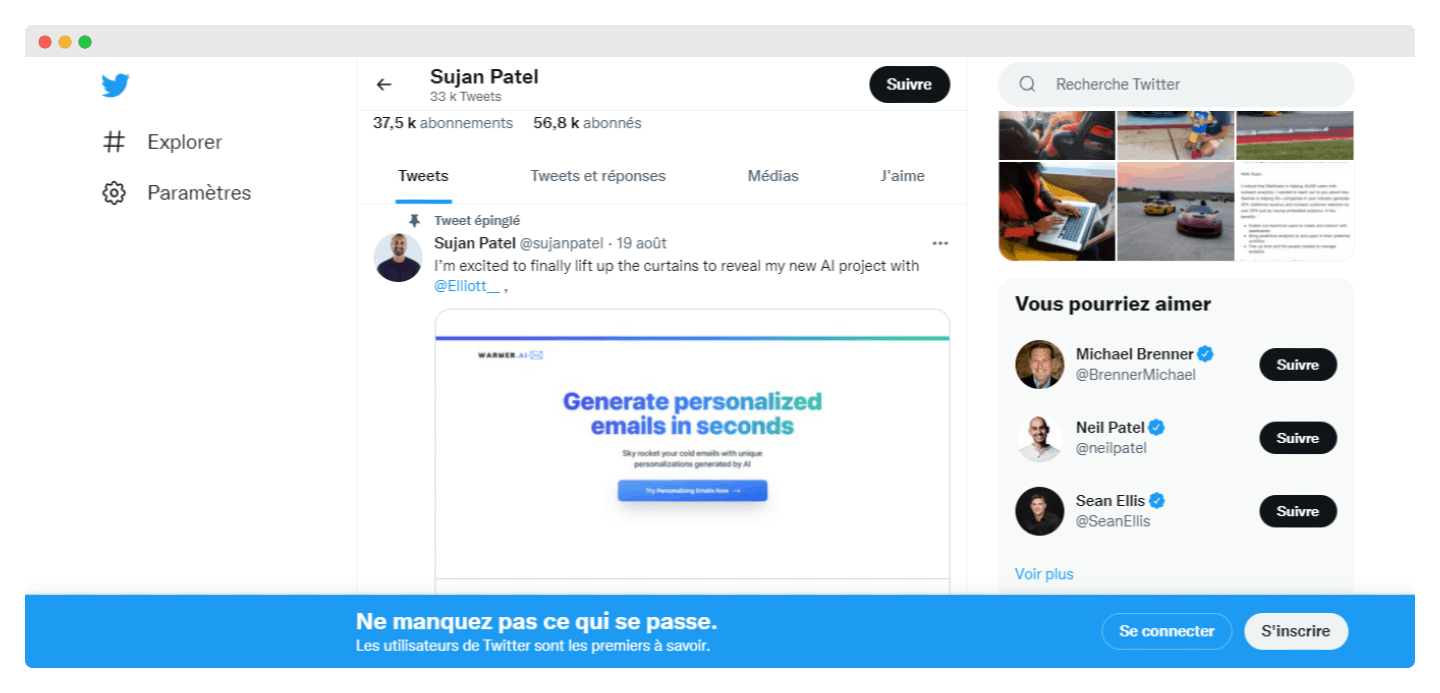
Now that you have this information, you can start the appeal by flattering them and focusing on the issues that matter most to them.
It also allows you to make the call warmer, by following this process:
- Take the time to identify your greatest opportunities
- Look for the content they create and engage with it.
- Share, comment and participate in their conversations on social networks.
Attention
If you are in the EU, or contacting someone within the EU, this approach has the added benefit of ensuring that your cold calls are GDPR compliant, as you know that this data is being used to pursue legitimate interests.
Structure your approach with NoCRM’s call plan generator
You can create your own scripts with NoCRM‘s call plan generator, taking care to include these elements of cold calling:
- Introduction: Keep it short and simple: say who you are and where you are calling from. Don’t hesitate to check that you are speaking to the right person before continuing.
- Opening: If you have chosen to personalise the call, you should link the introduction to the reason for your call by mentioning something in common with the person you are calling.
- Reason for the call: as presented in the CROC method, you should explain directly to your prospect the reason for your call.
- Offer : you can now present your business proposal, mentioning your partner companies, your results and what makes you different from your competitors.
- Questions: you can ask them in a more or less direct way if they are interested, in order to qualify your prospects.
- Conclude: What is the next step? Should you book a demo? A face-to-face meeting? Be clear about the action you want to take next and guide the prospect in that direction.
To make your task easier, tools such as NoCRM are available: free of charge and without subscription, it offers a Sales Script Generator to create cold calling scripts from a list of predefined questions.
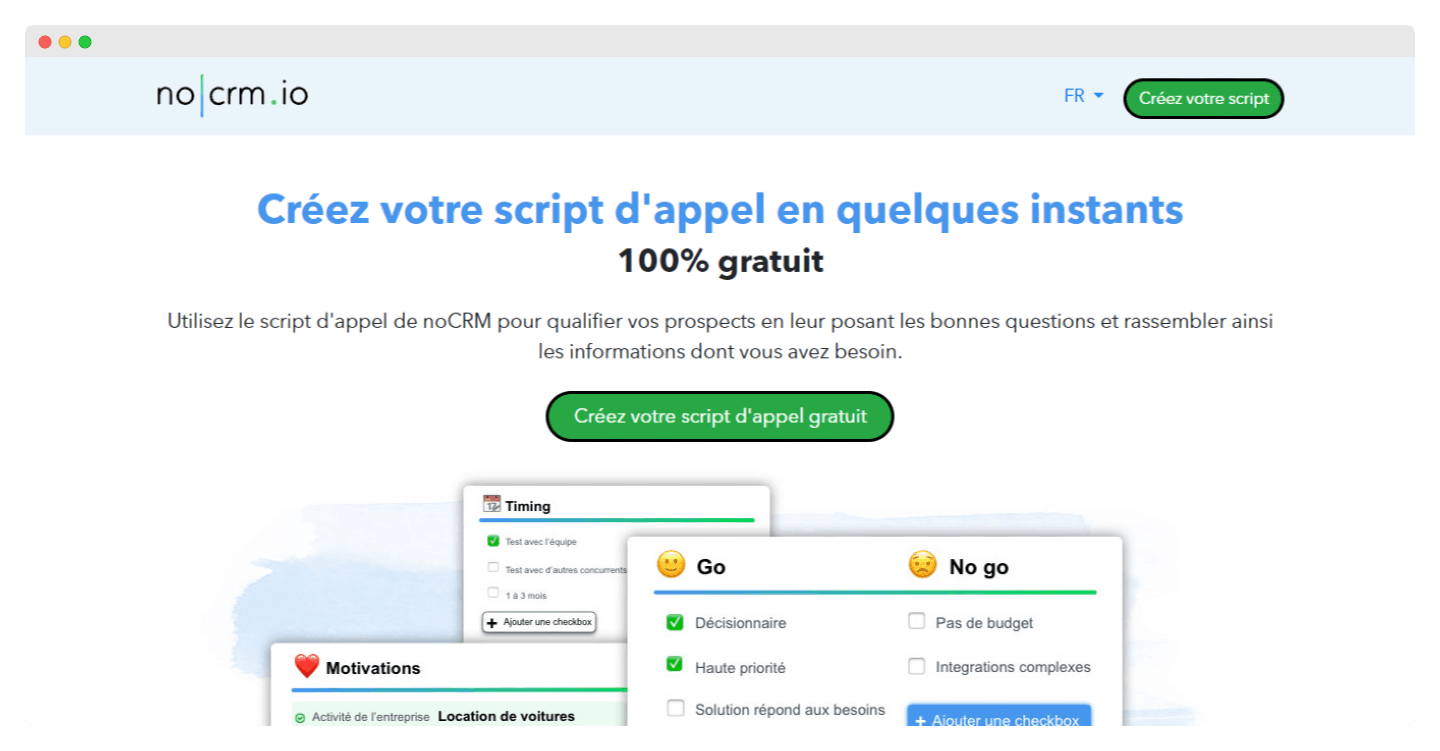
During the call, the salesperson can simply check boxes, quickly collect responses to score the opportunity. The information collected is then integrated into the prospecting software. Note that NoCRM has created templates for each sector of activity.
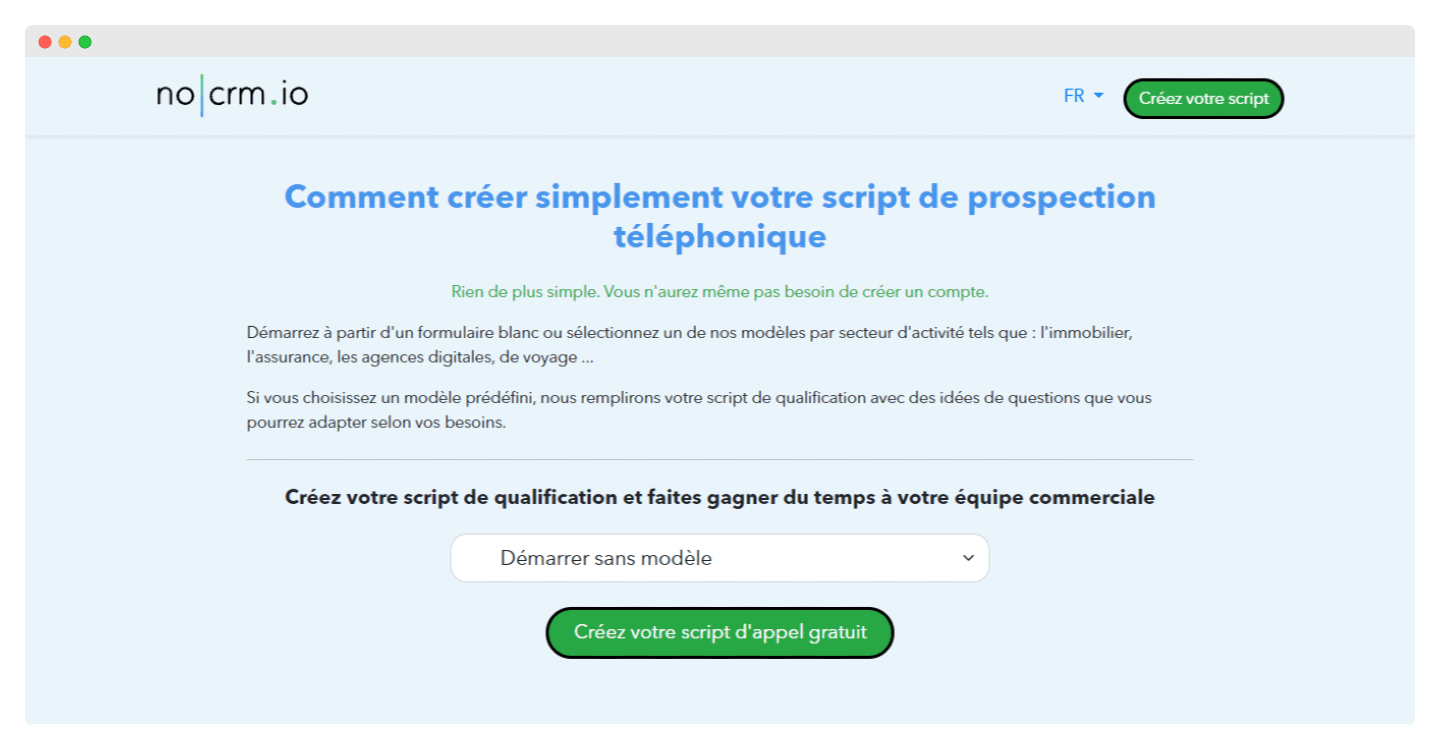
Try the noCRM script generator for free
The script generator is available free of charge, and is compatible with any CRM software.
Create an environment conducive to concentration
After making five calls, you probably want to get up and have a coffee, check Facebook or chat with your colleagues.
How can you combat these distractions? You can create an environment that helps you focus.
First of all, set personal goals. For example:
- Make calls between 9am and 11am each day.
- Make 30 calls per session before you get up
When they are done, you can reward yourself with a coffee or a quick browse through your social networks.
Of course, you need to achieve this goal several times during the day to meet your quota. But grouping these canvassing sessions together can help you stay focused.
Our opinion
Some people may need to change their usual environment completely. For example, if your workplace has private rooms, feel free to use them.
Learn by canvassing
As with any skill, you will not become a master cold call er overnight. Instead of focusing on results, focus on learning.
After each call, you should take the time to look at what you can do better. We all have weaknesses: the aim is to find in your script what may have put your callers off.
One effective method is to listen to your calls again, to improve not only your script but also the way you present it.

In the first few days, it is best to stick to your script so that you have a clear idea of what works and what does not. Then, when you feel more comfortable and the script seems less relevant, you can detach yourself from it.
Once you know the sticking point(s), you need to rewrite that part of the script, testing a completely new approach:
- New value propositions
- New methods of customisation
- New conclusion that requires less investment (30-minute call or face-to-face meeting).
The idea is to follow this process until you can follow your entire script for at least 50% of your cold calls.
Prepare for objections
Handling objections is an integral part of the sales game. But they can be difficult, which is why it is important to be prepared for them (and not to consider unsuccessful calls as a personal failure!).
Experience is essential here: the more calls you make, the more you will notice patterns in each objection.
Here are some common objections and how to deal with them:
- “I don’t have time to talk”: the prospect wants to hang up as soon as possible. Use this as an opportunity to ask them when is the best time for a 3-minute call. By offering a short time frame, you set limits and ask for a low level of investment.
- “Let’s talk about it in a month”: a common objection when a prospect cannot make a decision without their superiors. In this case, you can ask who is involved, whether you can participate and what you should bring with you.
- “Send an e-mail”: another classic to get you off the phone. Simply ask what information to include when you send them an email. Then follow up with a series of qualifying questions to get the prospect slowly but surely into the conversation.
Many prospects ask for more information (e.g. a follow-up email on sales), which indicates that you are not a priority for them: you need to show them that you are worth their time.
Pro tip
One trick is to get them to buy in a little at a time: you can start with a simple request (like their email address). You can then follow up with a relevant question: for example, what is their current marketing technology stack like (if you are selling a MarTech solution).
From there, you can try your luck with follow-up questions based on their response. Really listen to them and ask questions to get the conversation going. People love to talk about their work and their challenges, and this can be much more effective than a hard sell.
Finally, move on to the conclusion: emphasise the fact that you know they don’t have time, while trying to get an appointment. The aim is to link their difficulties to your offer and show how you can help them solve them. If your prospect still insists that you send an email, do so after thanking them for their time.
Timing and triggering events

Timing is an important factor in any sales strategy, regardless of the channel, but it should be given special attention in cold calling.
The time of day you pick up the phone determines your pick-up rate (and therefore your success rate).
To help you optimise the time of day you make these calls, it’s worth looking at some benchmarks. According to a study by InsightSquared, the best time to make cold calls is between 10am and 4pm:
- Response rates are highest around 10am
- There is a clear drop in the afternoon.
- Prospects are “less attentive” to sales calls after 5 pm.
Of course, every industry is different. That is why it is important to determine the best times for your prospecting calls.
Pro tip
This monitoring can be done manually using a sales dashboard, or with a sales technology stack that collects and analyses data.
Secondly, there are ‘trigger events’: these are those that occur within a target organisation or in a prospect’s career that offer the best opportunity to call.
The triggering events are as follows:
- New client companies: companies often make a public event of it. Don’t hesitate to take advantage of this by congratulating your prospect on this victory.
- Acquisitions and mergers: here too you can congratulate him. Better still, if it happens to an existing client, it’s an opportunity to make presentations up the chain.
- New hires: someone who fits your buyer persona has just joined a target account. They will want to prove their value and try new products and solutions.
- Funding: not only can you congratulate them on getting a new investment, but it is also an indication of a bigger budget for them to play with – a budget they can invest in your product or service.
Another reflex is to monitor behavioural triggers: for example, when someone opens your e-mails a certain number of times, or when a company has visited your website several times.
How do you kill it on your cold calls?

Finally, let’s look at how to be an effective salesperson on sales calls:
- Keep your objective in mind: whether it is to get appointments and a demonstration, it should always be kept in mind, as should the price of your offer. It also helps you to stay motivated and focused during your calls.
- Ask open-ended questions: prospecting calls should feel like a conversation, not a monologue. Rather than “Would you be willing to try a new CRM?”, it is better to ask “What are you looking for in a CRM?”
- It’s all aboutthem: don’t focus on yourself, your product or your solution. Get them to talk about their interests, their role and their challenges. Not only does this make prospects feel more comfortable, but it also gives you all the information you need to deliver the right experience.
- Include evidence and contacts: to build trust, it is always best to refer to other clients you have worked with before, if possible including specific cases and figures.
- Pay attention to tone: you can’t change your voice, but you can learn to change its tone to suit the situation. If the prospect sounds confused, try to simplify your language and be educational. If they seem to be in a hurry, it is better to stick to questions and shorten the explanations. Imagine that you are a chameleon when you pick up the phone.
- Learn to listen: the call is about your prospect, not you. Show that you are interested in them by asking specific follow-up questions based on what they say.
Be positive. Objections, rejections and angry prospects – everything about cold calling can test anyone’s character. But it is by keeping a positive attitude that you will succeed. Every call is objectively a learning experience. Don’t take it personally!
Going further
Tired of Excel files? A good CRM software allows you to take your prospecting to the next level. Discover our selection of the best free CRM software







